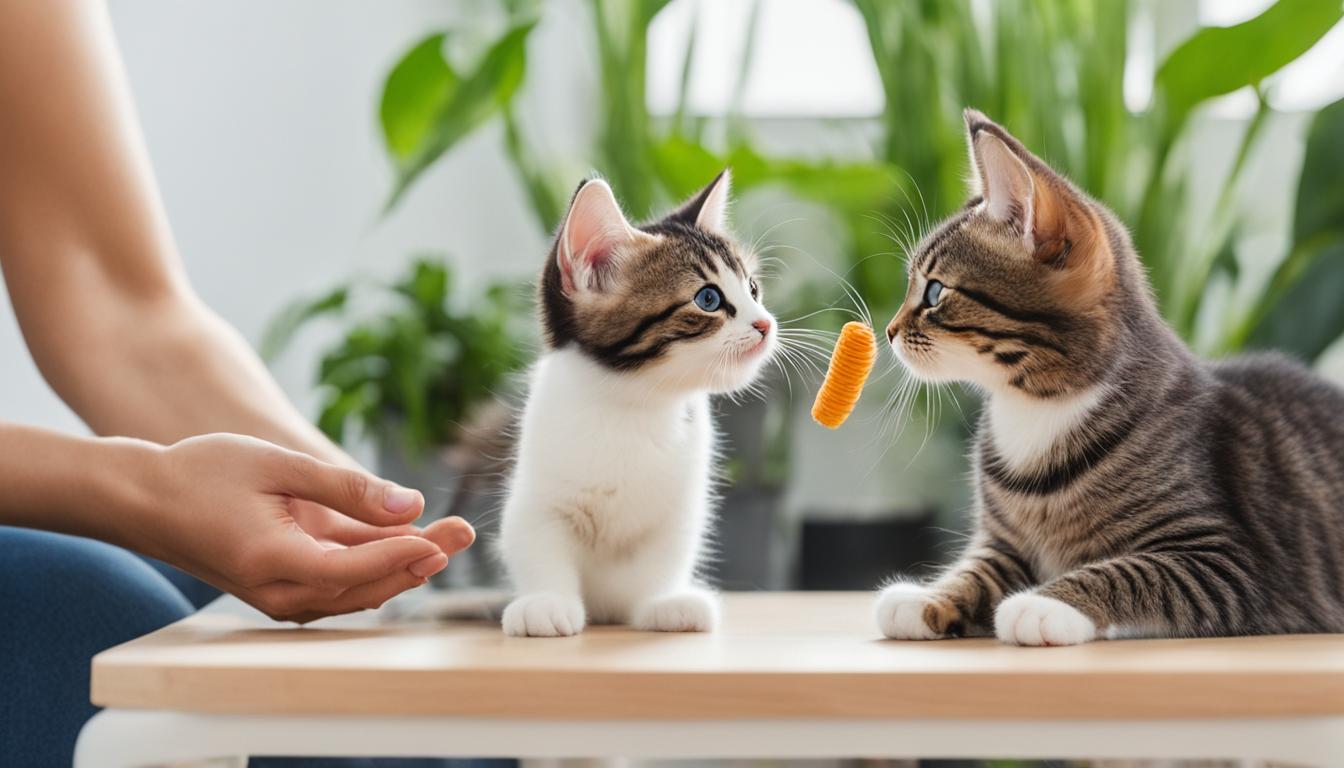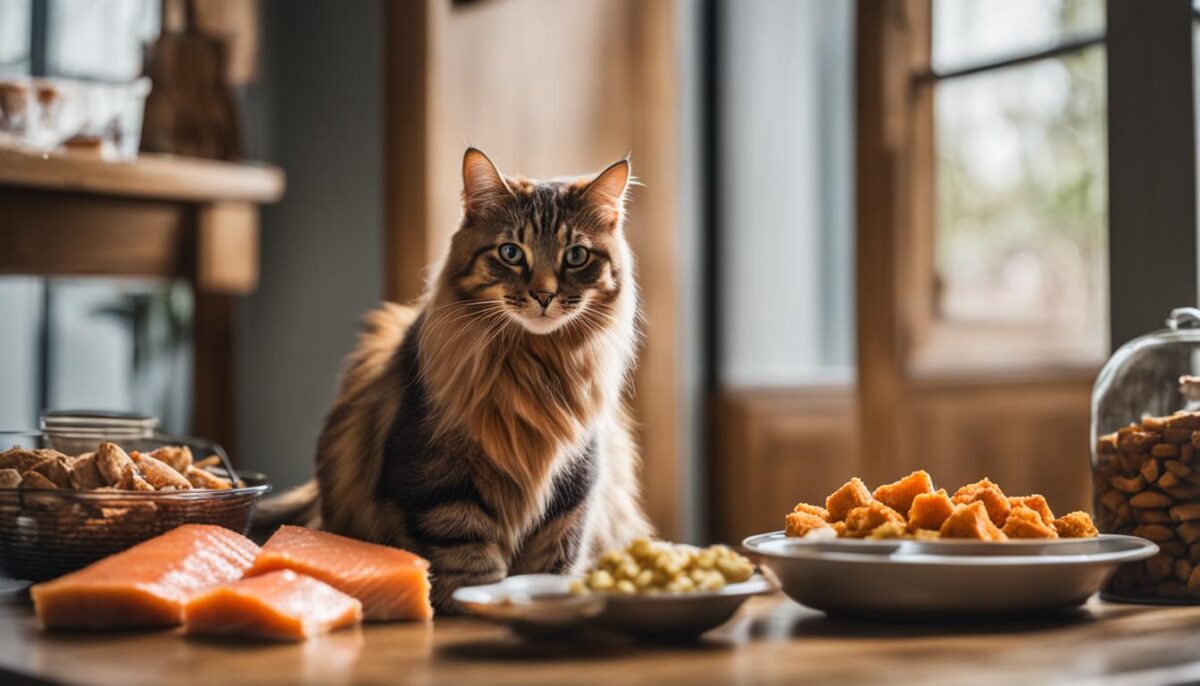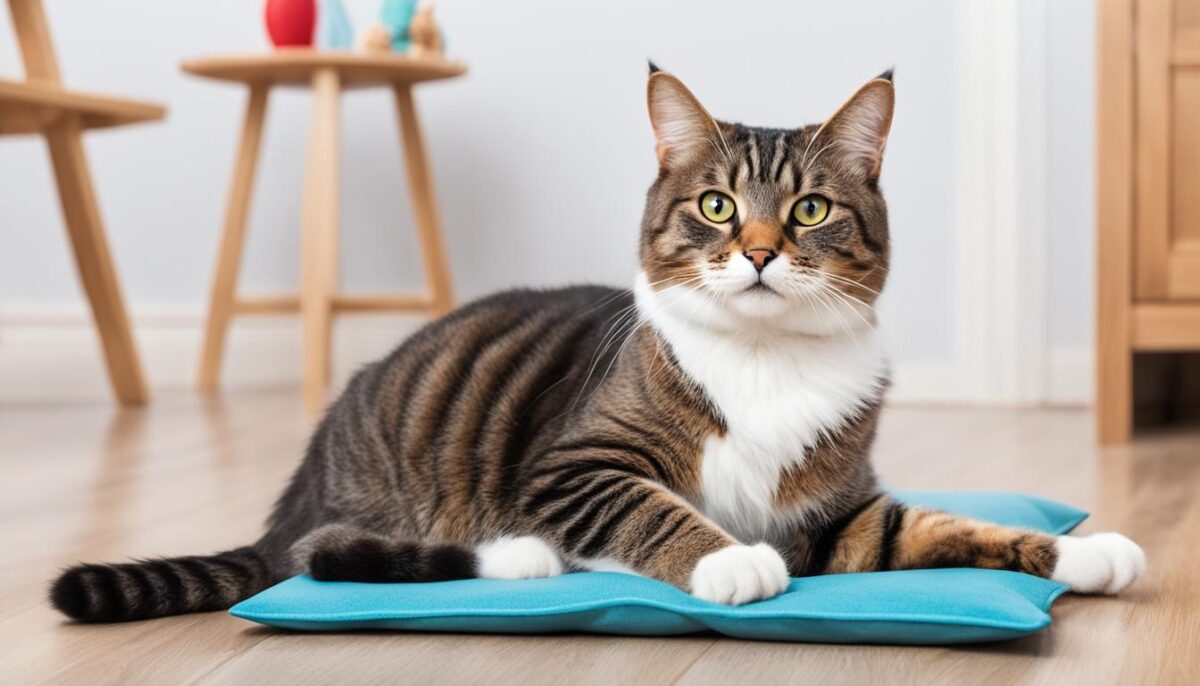Are you a cat parent? Training your furry friend can be a lot of fun for you both. It helps your cat learn cool cat tricks and good cat obedience. It’s not hard at all! You can train any cat, no matter their size or age. When you train with positive reinforcement, your cat gets treats for doing things right! This makes your cat happy and helps them learn faster.
You can do cat training at home. It doesn’t take long, and you can fit it into your day. Training your cat is a great way to play and talk with your cat. It helps you both understand what the other needs and likes. Every time you’re with your cat is a chance to train. And the best part? It makes your bond with your cat stronger!
Key Takeaways
- You can train your cat at home.
- Positive reinforcement means giving treats for good actions.
- Training is fun and makes your cat smart.
- Short training times fit your daily routine.
- Understanding your cat helps you both.
- Every moment with your cat can be a training moment.
- Training makes you and your cat’s bond stronger.
Understanding the Basics of Positive Reinforcement Cat Training
When you want to teach your cat how to be the best kitty, using positive reinforcement is a great way to go! It’s all about giving your cat a treat or a little ‘click’ from a clicker to say “good job” when they do something right. This is called clicker training, and it’s a kind of teaching that helps animals learn by rewarding them for their good behaviors.
Think of it like a fun game that you and your cat can play together. When your cat does something you like, you give them something they really enjoy, like a yummy treat or the sound of the clicker, which tells them they did a great job. This game helps you and your cat understand each other better, and it’s a cool way to help stop any naughty cat habits through cat behavior correction.
Let’s talk about the cat language your furry friend uses. Cats talk with their bodies, so when they’re happy and feeling good, you might see them purring or rubbing against you. When you’re training your cat with rewards, they’ll start to connect the happy feelings from the treats or the clicker with the good things they do. Pretty smart, right?
Here’s a list of things you’ll need to have a super fun training time with your cat:
- A bag of tasty treats your cat goes wild for
- A little clicker you can press when your cat gets things right
- A target stick that helps show your cat where to go or what to do
Just remember, when you use these training tools with your cat’s favorite snacks, it makes learning so much more exciting for them. Cats love food, and they’re really into playing this game when they know there’s a delicious treat waiting for them at the end!
Now, let’s take a peek at a simple table that shows some of the cool things you can teach your cat with clicker training:
| What Your Cat Learns | How You Teach It | What You Use |
|---|---|---|
| Sitting on cue | Press the clicker when your cat sits | Clicker and treats |
| High-fiving | Give a treat for a paw touch | Target stick and treats |
| Using the cat tree | Click and treat when they climb up | Clicker and their favorite cat tree |
So, now you know all about the basics of training your cat with positive rewards. This is your first step in becoming an amazing cat trainer. Have loads of fun, and watch your kitty turn into the smartest pet on the block!
Creating Engaging Training Sessions for Your Cat
Getting ready to train your cat can be fun and rewarding. Before you start, it’s a good idea to pick out yummy cat treats and find the perfect spot for you and your furry friend. Keep in mind, cats like things short and sweet, so short training times are best. Ready to learn how? Let’s dive in!
Choosing the Right Treats and Rewards
Your cat’s favorite treats can really help with training. To make your sessions super effective, use high-value treats your cat can’t resist. Remember to give these positive reinforcement rewards right after your cat does something great. This way, your cat will know they’ve done a good job.
Setting the Stage: Time & Place for Training
A quiet place without too much going on is the best training space for teaching your cat. Cats love a good routine, and they like to learn when they feel fresh and awake. Try to train them after a nap or at the same time every day, so it becomes part of your cat training schedule.
Keeping Sessions Short for Maximum Attention
Short play times are best for training because cats don’t pay attention for too long. About 5 to 10 minutes is all you need to keep your cat interested without making them tired or cranky. So keep it short for effective cat training!
Follow these simple steps, and you’ll be on your way to creating training sessions that your cat will enjoy. With good treats, the right place, and short sessions, you’ll both have fun and learn lots together!
The Role of Emotions in Cat Training and Behavior
When you’re training your cat, it’s not just about the tricks. It’s also about understanding cat emotions. Just like people, cats feel things like happiness or fear. By looking at their feline body language, you can tell how they feel. This helps you train them in a way that is kind and makes sense to them.
Reading Feline Emotions: Key to Better Training
Getting to know how your cat shows they are happy or scared helps a lot. When they feel good, training is fun! If they are scared, they might not want to pay attention. You can help them feel safe and have fun learning new things.
How Positive Reinforcement Affects Your Cat’s Wellbeing
When you teach your cat with treats and love, it makes them very happy. This fun play can help them feel good, like when they are playing in the wild. It can make them less bored or scared, because they feel like they are on a fun adventure. So, training your cat is a great way to make sure they are healthy, playful, and happy!
| Emotion | How Your Cat Shows It | What You Can Do |
|---|---|---|
| Happy | Purring, slow blinking, tail up | Keep playing and training, give them a treat |
| Scared | Hiding, tucking their tail, hissing | Be kind, don’t push them, make training a safe space |
| Curious | Ears forward, whiskers out, looking around | Use new toys or puzzles to make training interesting |
| Relaxed | Lying on their side, slow breathing, soft eyes | Perfect time for gentle petting or a cozy nap break |
Positive Reinforcement Cat Training: Techniques and Tools
When you start learning about clicker training cats, you might wonder about the magic behind the method. It’s all about positive connections! The clicker makes a sound. This sound tells your cat, “Hey, what you did just now is great!” Then, you give a tasty treat. Soon, your cat thinks, “When I hear the click, I did something good, and I get a yummy reward!”
Let’s talk about some simple cat training tools. First, you’ve got your clicker. This little gadget is easy to use. You press it, it clicks, and that’s your cat’s golden sound. Then there’s the target stick. This is like a pointer that helps your cat know where to go or what to touch. Last but not least, a treat pouch to keep those delicious rewards handy.
| Tool | What It Does | Why It’s Helpful |
|---|---|---|
| Clicker | Makes a clicking sound | Signals correct behavior instantly |
| Target Stick | Guides the cat to a specific spot | Teaches movement and touch-based tricks |
| Treat Pouch | Holds treats | Keeps rewards close for quick delivery |
Using positive reinforcement techniques is like playing a fun game with your cat. You cheer them on with the clicker, guide them with the target stick, and celebrate their wins with treats. This way, they learn new things and have a great time!
Remember, practice makes purr-fect! Keep up with the training and your fluffy buddy will be a pro at high fives, sitting pretty, or even running an obstacle course in no time!
Conclusion
As we wrap up, remember, teaching your cat with kind rewards is a super way to help them learn good behaviors. It’s like giving a high-five for a job well done! Doing this makes both you and your cat happier, and helps them understand how to be their best. You’ll see their behaviors get better, their brains get a fun workout, and your friendship will grow super strong.
Recap of Positive Reinforcement Benefits
Let’s take a quick look back at all the great stuff about using rewards with your cat. It’s all about the positives like better behavior and making learning fun. When you use treats and praise to teach your cat, they will want to learn more and make you proud. Plus, it’s a lot more fun to work together with smiles and treats instead of being upset or frowning!
Taking Further Steps: From Training to Lifelong Bonding
Training time is not just about learning tricks. It’s really about building a forever friendship with your furry buddy. Every time you practice together, you learn a little more about each other. That makes every day you spend together something special. Just remember, it’s the fun and care you share that make being a cat owner one of the best adventures ever!
FAQ
What is positive reinforcement in cat training, and why is it important?
Positive reinforcement in cat training is a method that uses rewards to encourage your cat to repeat desired behaviors. It’s crucial because it improves communication between you and your cat, strengthens your bond, and promotes a positive and stress-free learning environment.
Can all cats learn tricks and obedience skills through positive reinforcement?
Yes! Cats of all breeds, ages, and sizes can learn tricks and obedience skills through positive reinforcement. This method provides mental stimulation and enriches their lives while fostering a deep sense of understanding between you and your feline friend.
How does clicker training work with cats, and is it effective?
Clicker training for cats is a form of operant conditioning where a click sound is used as a secondary reinforcer immediately after a desired behavior is performed. This sound is then associated with a primary reinforcer, like a treat, making it an effective method for cat behavior correction and language development.
What kind of treats should I use for cat training sessions?
For cat training sessions, high-value treats that are especially irresistible to your cat are recommended. These treats should be given immediately after the desired action to make a clear connection between the behavior and the reward. Choose treats that are used solely during training to maintain their allure.
What is the best time and place to conduct cat training sessions?
The best time for cat training is when your cat is alert and attentive, such as after waking up from a nap. Select a calm and quiet space free of distractions as your training area. Establishing a routine time each day can also help your cat get into the habit of training sessions.
How long should my cat training sessions be?
Cat training sessions should be short to keep your cat’s attention without causing stress. A focused 5 to 10-minute session is typically sufficient. It’s important to observe your cat’s behavior and adjust the length of the training to avoid overwhelming them.
How can I tell if my cat is emotionally receptive to training?
Understanding your cat’s emotions is key to successful training. Signs of a cat being receptive include a calm demeanor, curiosity, and responsiveness to your cues or rewards. Observe their body language, such as a relaxed posture and forward ears, to gauge their emotional state.
In what ways does training with positive reinforcement affect my cat’s wellbeing?
Positive reinforcement training greatly benefits your cat’s wellbeing by providing mental stimulation, reducing boredom, and releasing dopamine in their brain. It enhances their mood and can help in preventing issues like anxiety or depression by mimicking natural hunting reinforcements.
What tools should I have on hand to start training my cat using positive reinforcement?
To start training your cat using positive reinforcement, you’ll need a few key tools. These include a quiet clicker for clicker training, a target stick for guiding your cat, and a treat pouch to hold the high-value rewards you’ll be using to reinforce the desired behaviors.
How does positive reinforcement influence the relationship between a cat and its owner?
Positive reinforcement vastly improves the relationship between a cat and its owner by creating clear lines of communication. This method allows you to gently guide your cat’s behavior in a rewarding way that builds trust and mutual respect, deepening the bond you share.


